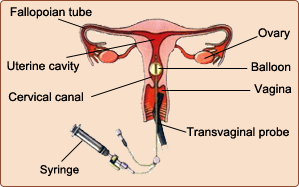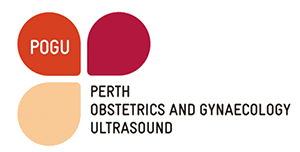
HyFoSy is an ultrasound-based technique that is used to detect abnormalities of fallopian tubes or tubal blockage using ExEm foam gel. It is a safer alternative to the traditional hysterosalpingogram (HSG) or laparoscopy and dye test to check tubal patency.
Fallopian tube abnormalities account for up to 40 % of female subfertility. Normal fallopian tubes are not seen on a routine pelvic scan, but the bright echoes produced by ExEm foam gel can be used to demonstrate the tubes. Until recently, this procedure used to be known as HyCoSy (Hysterosalpingo-Contrast-Sonography) as a contrast medium called Levovist was being used to outline the tube. Levovist is now no more available in Australia.
What are the common indications for having HyFoSy?
- Investigation of sub-fertility
What are the advantages of having HyFoSy?
- There is no radiation or iodinised contrast material involved.
- HyFoSy is less uncomfortable than HSG as the fluid injected produces less irritation than the dye used in HSG.
- It helps to avoid anesthesia and hospitalisation associated with laparoscopy.
- Ultrasound examination allows assessment of other pelvic structures
How is this procedure organised?
A preliminary routine pelvic ultrasound is booked first especially if you haven’t had one done within 6 months of having HyCoSy. This is essential as it helps to identify certain situations where HyCoSy may not be feasible. If there is an abnormality detected which needs further assessment by your doctor, HyFoSy may not be performed.
How long does this procedure take?
It usually takes about 10-15 minutes to do the procedure.
When is the best time to have HyFoSy done?
It is best done between Day 5- Day 10 of the menstrual cycle taking the first day of your periods as Day 1.
If you are unsure please contact us to discuss the timing of the procedure especially if you have irregular or infrequent periods.
How exactly HyFoSy is done?
A full bladder is not necessary for the procedure and hence bladder is emptied just prior to the procedure. Initially a transvaginal scan is done to assess the pelvic anatomy. Following this, a speculum is placed in the vagina and the cervix is cleaned using an antiseptic solution. A fine sterile plastic catheter (2mm) is then passed through the cervix. Once the tip of this catheter is in the uterine cavity, the small balloon at the tip is inflated to keep the catheter in place. Vaginal probe is introduced again taking the speculum out. Scan is performed as the ExEm foam gel is injected through the catheter. The bright echoes generated by ExEm foam gel make visulisation of entire tube and the spillage around the ovaries much easier to see. When spilling is seen easily on both the sides, the fallopian tubes are considered to be patent. When spilling is not seen, however, it cannot be concluded that they are blocked as sometimes the spasm of the uterus can temporarily occlude the opening of the fallopian tubes. If such situation arises, you referring doctor will organise further testing of tubal patency.

Will I need pain relief for the procedure?
A single dose of 2 tablets of Nurofen, or similar, is recommended � – 1 hour prior to your appointment time. If you cannot tolerate anti- inflammatory medications, 2 tablets of Panadol may be taken as an alternative. Some women find the procedure slightly more uncomfortable than the others.
Will I need to take antibiotics before the procedure?
In general it is not necessary. However it may need to be considered in certain circumstances and you should discuss this with your doctor. The prescription is given to you by your doctor and the antibiotics to be taken 2 hours prior to having HyCoSy.
What other information I need to know about the procedure?
You can expect a discharge from the vagina for about 24 hours, so you may like to bring a liner for your underwear. Most women tolerate the procedure well, though some do have more severe cramps. For this reason, you may consider having a support person with you, who can drive you home.

